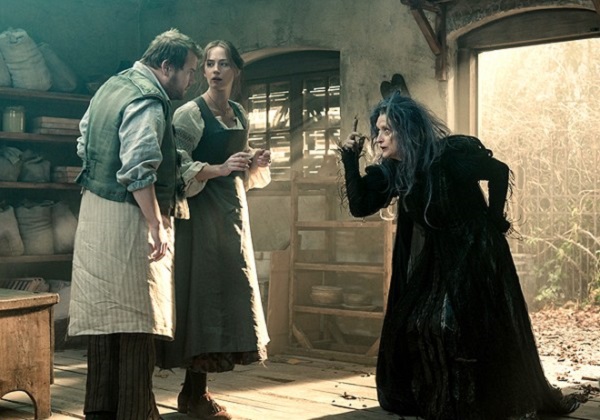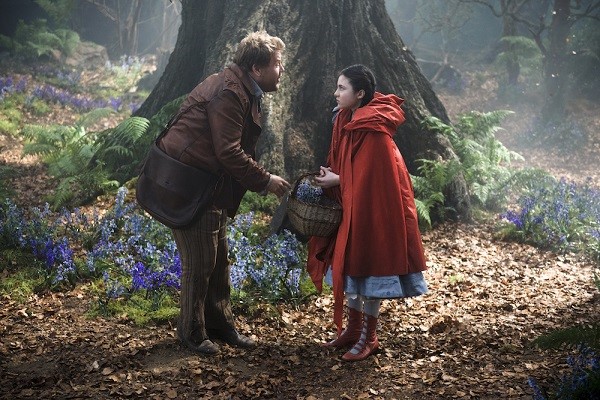Into the Woods Review
How I’ve never seen a stage version of Stephen Sondheim’s “Into the Woods” is still a head-scratcher. My high school theatre department put on the twisted fairy tale the year after I graduated (much to my disappointment) and it has eluded me ever since. The point, excuse my digression, is it’s very rare for me to go into a movie musical knowing very little of the show, but after seeing the film and chatting with those who have seen the show, it’s clear director Rob Marshall and Disney’s take delivers the very qualities that made the stage musical a hit.
It helps to know that James Lapine, who wrote the book of the musical, wrote this screenplay. Even though he doesn’t have final say in the film, there’s no criticizing the movie’s loyalty to the source material. This is not a Disney-fied version despite the marketing-savvy casting moves of Meryl Streep as the Witch and Johnny Depp as the Wolf. This is every bit as dark, fantastical, quirky and unusual as fans of the show have led me to expect.
“Into the Woods” is an amalgamation of Cinderella, Little Red Riding Hood, Jack and the Beanstalk and Rapunzel all centered around the story of a Baker (James Corden) and his wife (Emily Blunt) who discover they cannot have a child because a witch (Streep) put a curse on the Baker’s father many years ago. The only way to reverse it, she says, is to go into the woods and retrieve her a cow as white as milk, a cape as red as blood, hair as yellow as corn and a slipper as pure as gold. So off they go into the woods, as do the fairy tale characters whom they seek.
This is not some what it looks like: a fun super mash-up of classic stories. Rather, it’s a way to explore the human truths of the fairy tale genre as Sondheim does so beautifully in his lyrics. Everything about “Into the Woods” is just a bit off from what you’d expect: not too whimsical, not too intellectual, not too dark and scary, not too childish, etc. It lives in this gray area, which makes it totally unique as a work of art, albeit a bit frustrating for the movies, where audiences like to see exactly what they expect to see. Yet there seems to be “just enough” of each of these elements to make “Into the Woods” a likable film for all.
Although few are as skilled as Marshall at effectively filming a musical performance for the big screen, so much of the credit for what makes “Into the Woods” enjoyable is the cast. Streep, for example, has precisely the gravitas needed for the Witch, and it’s exciting to watch such a venerated actress taking on a peculiar character. She’s really the tip of the iceberg though. Blunt and Anna Kendrick (who plays Cinderella) are two of the best and most versatile actresses of their generation, and they have pipes to boot; Corden, little-known but rising quickly, strikes a terrific balance of humor, pity and heart; Youngsters Daniel Huttlestone (Jack) and Lilla Crawford (Little Red Riding Hood) are terrific finds; and although with less significant roles, Chris Pine and Billy Magnussen as the princes get the film’s most entertaining musical number in “Agony.”
Each of these actors connects with and owns the lyrics, which are the heart of the story and the true magic of “Into the Woods,” but in the wrong hands (on the wrong tongues?) can feel inaccessible or superfluous. Cinderella’s song “On the Steps of the Palace,” for example, is her overanalyzing and being indecisive about whether (for the third time) she should run away from her Prince. It’s lyrical word vomit, and while Kendrick doesn’t turn it into pure gold, she effortlessly communicates her character’s inner albeit excessive dilemma and makes Sondheim’s point that just because in fairy tales girls are supposed to fall in love with charming princes, doesn’t mean they should run off with them without a second thought.
In this example it’s also easy to see that “Into the Woods” can get a bit wordy and boring. It’s a fairy tale story, so we expect something breezy and entertaining, not something existential and overbearing. As much as you can appreciate how Lapine and Sondheim have challenged the notion of fairy tales by turning them around on the audience, at some points it just gets boring. The film’s third act, when “happily ever after” gets turned on its head, for example, is a test of patience, even though without it, the story would have no meaning and the film would therefore become artistically pointless.
This problem doesn’t seem to be unique to the film, but rather, has followed the show to the big screen. All the cinematic elements work nicely here from visual effects to Colleen Atwood’s costumes; this is certainly the type of story that truly stands to benefit from escaping the confines of a stage. Even so, Marshall doesn’t use that as license to overdo it; he gives us tastes of visual effects here and there. In a sense, this is staying true to the musical, because it’s not supposed to be a pure entertainment piece.
“Into the Woods” doesn’t get better on the silver screen, but it clearly doesn’t get worse, as most fans of stage musicals fear when their favorites get adapted. I might not be able to speak from experience, but what was a likable albeit slow musical according to my “sources” has become a likable albeit slow film. Considering “Into the Woods” has a very specific message and style, the fact that Marshall and Disney honor that is something deserving of some praise.
3.5/5 Stars
Into the Woods
Directed by Rob Marshall
Written by James Lapine
Starring: Meryl Streep, Emily Blunt, James Corden, Anna Kendrick







0 Comments
You can be the first one to leave a comment.